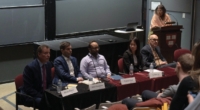Probabilistic machine learning methods are becoming increasingly powerful data analysis tools, but there is more to determining their accuracy and effectiveness than just mathematics. A team of researchers has created a classification system known as a “taxonomy of trust” to address this issue. The system defines where trust may break down in data analysis and identifies strategies to strengthen trust at each step. They also identify issues that have been thoroughly researched and those that require additional attention. For example, owning goats may be considered an investment in rural Mexico. While checking the code that runs an algorithm may seem prosaic, it can strengthen trust, especially in situations where standard software packages are available. Requiring journals to mandate the release of code can be a crucial first step in building trust in machine learning models. Broderick and Gelman collaborated on an analysis forecasting the 2020 U.S. presidential election using real-time state and national polls. They published daily updates in The Economist magazine while making their code available online for anyone to download and run.
Strengthening Trust in Machine-Learning Models: A “Taxonomy of Trust” to Identify Confidence in Data Analysis

Machine learning (ML) is increasingly used in various fields, including science, social science, and engineering, where it has the potential to impact people’s lives profoundly. However, it is crucial to ensure that the probabilistic ML outputs are useful for the intended purposes of the users. This can be challenging as probabilistic machine learning methods are becoming more powerful data analysis tools.
To tackle this issue, a team of researchers developed a classification system called a “taxonomy of trust.” This system defines where trust may break down in data analysis and identifies strategies to strengthen trust at each step of the process. According to the researchers, many subjective choices and human errors can creep into data analysis, which can erode users’ trust in the quality of the decisions based on these methods.
The “taxonomy of trust” outlines points in the data analysis process where trust may be lost, including the selection of mathematical models that best represent the real-world issue or question they are trying to solve. Analysts choose the appropriate algorithms to fit the model and use code to run those algorithms. Each of these steps poses unique challenges around building trust. Additionally, analysts decide which data to collect, which also presents specific trust-building challenges.
The accuracy of some components can be verified through measurable ways. For instance, one question that can be examined against objective standards is whether the code has bugs. However, problems that are more subjective and lack obvious solutions require different strategies to gather data and determine whether a model accurately represents the real world.
The team behind the “taxonomy of trust” aims to draw attention to issues that have already been thoroughly researched and those that require additional attention. According to Tamara Broderick, a computer scientist from MIT, the system highlights where people are focusing, with much research naturally focusing on whether algorithms can solve a particular mathematical problem. However, there is a need to answer whether it is reasonable to mathematize an important applied problem in a particular way, which is a more challenging problem that goes beyond mathematics.
In conclusion, the “taxonomy of trust” provides a useful framework for building confidence in data analysis and ensuring that probabilistic machine learning methods are used effectively. By identifying where trust may break down in the data analysis process, researchers can develop strategies to strengthen trust and enhance the usefulness of ML outputs.
Strengthening Trust in Machine-Learning Models: Categorization of Trust Breakdown
Researchers have developed a classification system called a “taxonomy of trust” to identify where trust may break down in data analysis and strategies to strengthen trust at each step of the process. The system is rooted in a real-world application and was demonstrated through a case study conducted by one of the co-authors, Meager. Meager examined whether microfinance could benefit the community, providing insights into how to reduce the risk of trust failing in various situations.
Defining Positive Outcomes
Analysts must define what they consider a positive outcome when evaluating the benefits of microfinance. In economics, measuring the average financial gain per business in communities where a microfinance program is introduced is standard practice. However, reporting an average may imply a net positive effect even if only a few people benefited rather than the entire community.
Contextualizing the Available Data
Analysts must assess whether specific case studies can reflect broader trends to contextualize the data. It is also critical to contextualize the available data. For example, owning goats may be considered an investment in rural Mexico.
Defining Real-World Problems
Finally, analysts must define the real-world problems they hope to solve. Measuring the quality of life of an individual is challenging, and people often measure things like business profit or household consumption level. However, there is potential for a mismatch between what is measured and what is ultimately cared about. Thus, it is essential to consider the data and assumptions relied upon before getting to the mathematical level.
Challenges in Trust Building
While checking the code that runs an algorithm may seem prosaic, it can strengthen trust, especially in situations where standard software packages are available. The researcher pointed out that practitioners might use standard machine learning tools because non-standard methods might be less familiar or accepted in peer review. This can lead to a mismatch between the proxy measured and the quantity of interest, which can impact trust.
Conclusion
In conclusion, the “taxonomy of trust” is a useful framework for building confidence in data analysis and ensuring that probabilistic machine learning methods are used effectively. Measuring the benefits of microfinance illustrates how trust can break down in data analysis, highlighting the importance of defining positive outcomes, contextualizing the available data, and defining real-world problems. By identifying where trust may break down in the data analysis process, researchers can develop strategies to strengthen trust and enhance the usefulness of machine learning outputs.
Strengthening Trust in Machine Learning Models: Checking Code Reproducibility
One way to catch bugs in machine learning code is to test its reproducibility. However, depending on the field, sharing code alongside published work is not always required or considered the norm. As models become more complex over time, it becomes more difficult to recreate the code from scratch, making it difficult to replicate the model.
Building Trust by Sharing Code
Requiring journals to mandate the release of code can be a crucial first step in building trust in machine learning models. While code may not be double-checked, the researchers acknowledge that sharing code alongside published work can enhance reproducibility and build trust.
Real-World Example of Sharing Code
In a collaboration between Broderick and Gelman, they analyzed the 2020 U.S. presidential election using real-time state and national polls, publishing daily updates in The Economist magazine. They made their code available online for anyone to download and run, demonstrating how sharing code alongside published work can enhance trust.
Conclusion
In conclusion, testing code reproducibility is one way to catch bugs in machine learning models. Sharing code alongside published work can also enhance reproducibility and build trust, even if there is no single solution for creating a perfect model. Requiring journals to mandate code release can be a crucial first step in building trust in machine learning models.
Don’t miss interesting posts on Famousbio










